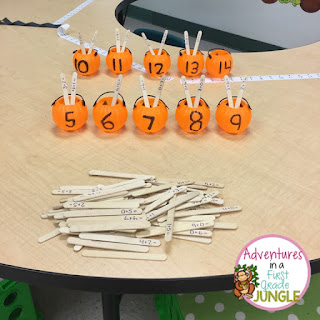I love simple, interactive activities for math. I love watching my kiddos explore in math and learn things in a hands on way. It gets even better around this time of year because there are so many holidays to make the activities even more exciting and unique for them.
This month we have been enjoying all things Halloween and Fall. We have been using Candy Corn for several of our math centers. In the picture below we didn't have actual candy corn on hand the day the picture was taken but typically we use it. We were playing roll and cover with two dice. We started practicing adding 1 to the answer of the two dice and then we practiced subtracting 1. They had a lot of fun. We will also be using candy corn later this week in a measurement and graphing activity. These candy corn activities are from Sarah Cooley's Candy Corn Math-tivities packet.
We have also used the pumpkins below to practice adding. I found these at Walmart on clearance a few years ago. We only used them for addition this year; however my kiddos found it fun to race each other to make it more exciting. They would split the sticks among themselves and then see who could solve their math problems first. It was fantastic! They were so focused on their math facts!!
My favorite activity this month though would have to be our candy corn "people." We had a crazy week last week and one of my math days got cut up so I didn't have enough time to teach a full lesson. Instead I turned it into a practice day. We needed more practice with adding 1 so I made a candy corn template and math sheet to go with it. They solved their math and then made their candy corn person. The math attached to the back. It was simple, fun, and looks cute hanging from my ceiling.
So these are definitely not fancy activities but I love that it got their attention and kept them engaged in their lessons.
Thanks for reading about a few fun math things I have done this month.




































